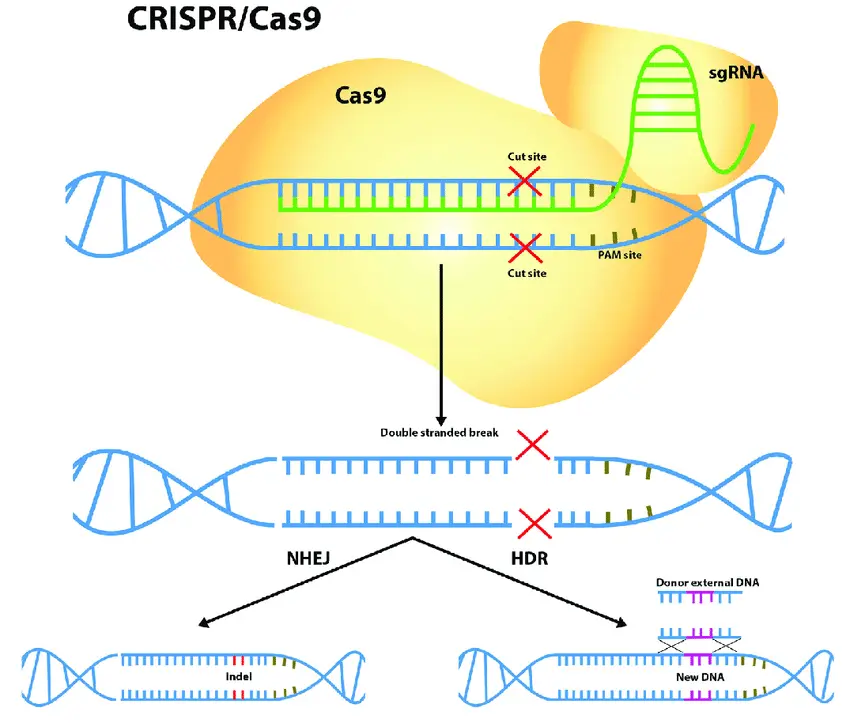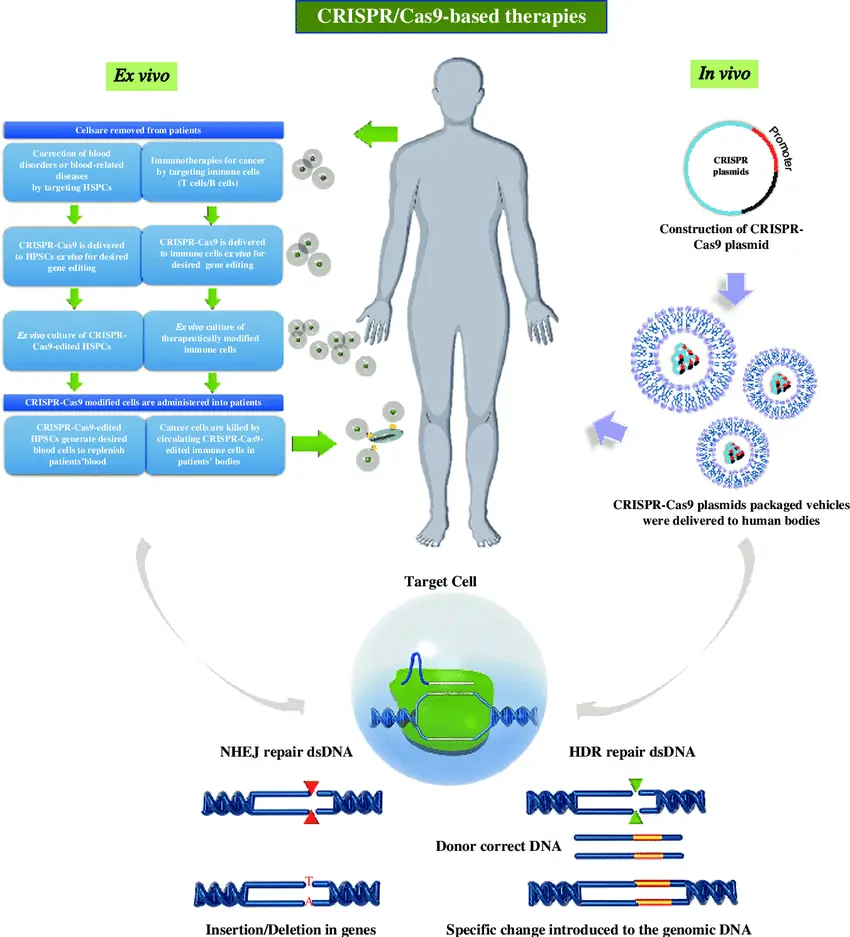CRISPR-Cas9 is transforming the landscape of genetic engineering and biotechnology. This groundbreaking gene editing tool allows scientists to precisely alter DNA sequences in virtually any organism, opening new frontiers in medicine and fundamental biology.
What Is CRISPR-Cas9?
CRISPR stands for Clustered Regularly Interspaced Short Palindromic Repeats, a unique sequence of DNA found in the genomes of bacteria and archaea. These sequences are part of a natural defense system that helps microbes fend off viral infections. The Cas9 protein (CRISPR-associated protein 9) is an enzyme that acts like molecular scissors, cutting DNA at specific locations.
Together, CRISPR and Cas9 form a powerful gene-editing system. Scientists can program CRISPR-Cas9 with a synthetic guide RNA (gRNA) to target virtually any DNA sequence. Once targeted, Cas9 introduces a double-strand break, which the cell then repairs either disrupting a gene or enabling insertion of new genetic material.
How Does CRISPR-Cas9 Work?
At its core, the CRISPR-Cas9 system functions as a programmable genetic scalpel, capable of locating and modifying virtually any DNA sequence in a cell. It is based on a natural bacterial immune defense mechanism but has been re-engineered for precision genome editing in higher organisms, including humans.
The CRISPR-Cas9 gene-editing process involves four critical components working in concert:
1. Guide RNA (gRNA)
The guide RNA is a specially engineered, short strand of synthetic RNA (~20 nucleotides) that is designed to be complementary to a specific DNA sequence within the target genome. It plays the role of a homing device, directing the Cas9 enzyme to the precise location where a genetic edit is desired. The gRNA is typically composed of two parts:
- A CRISPR RNA (crRNA) that matches the target DNA.
- A trans-activating crRNA (tracrRNA) that binds to Cas9 and helps stabilize the complex.
2. Cas9 Enzyme
Cas9, short for “CRISPR-associated protein 9,” is a powerful endonuclease derived from the bacterium Streptococcus pyogenes. Once the guide RNA binds to the DNA, Cas9 cleaves the DNA strand at a specific site adjacent to a sequence known as the PAM (Protospacer Adjacent Motif). For SpCas9, the PAM is typically the sequence “NGG” (where “N” is any nucleotide).
Cas9 introduces a double-strand break (DSB) in the DNA, effectively cutting both strands of the DNA helix at the target site. This break triggers the cell’s natural DNA repair mechanisms, which can then be harnessed for gene editing.
3. Target DNA
The target DNA refers to the specific genomic region that researchers wish to modify. The location must include a PAM sequence near the desired cut site to be accessible by Cas9. Targeting is highly sequence-specific, and even a one- or two-nucleotide mismatch between the guide RNA and the target DNA can sometimes prevent binding—though off-target effects can still occur, especially if the mismatches are near the distal end of the gRNA.
4. DNA Repair Mechanisms
Once Cas9 has successfully created a double strand break at the target site, the cell must repair the damage. This is where the actual gene editing takes place. There are two main repair pathways:
a) Non-Homologous End Joining (NHEJ)
- NHEJ is the cell’s default repair process for DSBs. It quickly rejoins the broken DNA ends without using a template.
- However, this method is error-prone and often introduces small insertions or deletions (indels) at the site of the break.
- These indels can disrupt gene function by causing frameshift mutations or premature stop codons, effectively knocking out the gene.
- NHEJ is useful for experiments aiming to disable a gene or screen gene function using CRISPR knockouts.
b) Homology-Directed Repair (HDR)
- HDR is a template-driven repair mechanism that allows for precise editing.
- Scientists can introduce an artificial DNA repair template (called a donor template) containing the desired changes, such as a point mutation, gene insertion, or tag sequence (e.g., GFP).
- The cell uses this template to accurately repair the break, incorporating the new genetic information into the genome.
- HDR is typically used when exact genetic correction is required, such as in therapeutic gene editing or when inserting reporter genes in research.
- However, HDR is less efficient than NHEJ and occurs primarily during the S and G2 phases of the cell cycle when a sister chromatid is available.
Applications of CRISPR-Cas9 in Biotechnology
The introduction of CRISPR-Cas9 has ushered in a new era of genetic precision, fundamentally transforming the field of biotechnology. Its simplicity, adaptability, and cost-effectiveness have enabled researchers and companies to unlock new solutions across diverse domains from human health and agriculture to synthetic biology, environmental engineering, and industrial manufacturing.
1. Medical Biotechnology
a. Gene Therapy for Genetic Disorders
CRISPR is being used to correct mutations responsible for inherited diseases. Notable examples include:
- Sickle Cell Anemia and β-Thalassemia: Clinical trials using CRISPR-edited hematopoietic stem cells (CTX001 by CRISPR Therapeutics and Vertex) have shown promising results in curing these blood disorders.
- Cystic Fibrosis: Efforts are underway to correct CFTR gene mutations in lung epithelial cells.
- Leber Congenital Amaurosis (LCA10): Editas Medicine launched the first in vivo CRISPR human trial for treating a form of inherited blindness by directly editing photoreceptor cells in the retina.
c. Infectious Disease Control
- CRISPR is being tested to disable viral DNA integrated into the host genome, such as HIV provirus.
- Cas13 (an RNA-targeting CRISPR enzyme) is being developed to attack RNA viruses like SARS-CoV-2 and influenza.
3. Synthetic Biology and Metabolic Engineering
CRISPR-Cas9 is a critical tool for rewiring metabolic pathways in microorganisms and cell lines to produce valuable compounds.
a. Biofuel and Biochemical Production
- CRISPR is used to modify yeast and algae to enhance the synthesis of bioethanol, biodiesel, and biobutanol.
- Engineering E. coli and Corynebacterium to produce amino acids, bioplastics, or vitamin precursors.
b. Synthetic Organisms
- Companies are using CRISPR to design minimal genomes in bacteria for industrial purposes.
- Creating custom microbes to produce pharmaceuticals, aromatics, or specialty chemicals.
c. Programmable Biosensors
-
dCas9 (nuclease-dead Cas9) is used in gene circuits and biosensor platforms for detecting toxins, pathogens, or environmental pollutants in real time.
5. Industrial and Pharmaceutical Biotechnology
Cell Line Development
- CRISPR-edited CHO cells, HEK293, or yeast strains are optimized for large-scale production of monoclonal antibodies, vaccines, and biologics.
- Reduced glycosylation variability and increased protein yields.
6. Research and Education
CRISPR has democratized access to gene editing:
- Model organisms such as zebrafish, fruit flies, and mice can now be modified in weeks rather than years.
- CRISPR kits are used in high school and university education to teach students hands-on genetic engineering.
- Custom CRISPR editing is routinely performed in labs for gene function analysis, promoter studies, and epigenetic research.
The Future of CRISPR-Cas9
As CRISPR-Cas9 technologies advance, we are entering an era of programmable biology. Future prospects include:
- Personalized medicine tailored to individual genetic profiles.
- Synthetic organs and tissue regeneration.
-
Global disease eradication using gene drives (malaria control in mosquitoes).
Conclusion
CRISPR-Cas9 is a powerful tool that has changed the way we approach biotechnology. It allows scientists to edit genes quickly and accurately, helping to improve crops, develop new medicines, and create useful microbes for industry. As research continues, CRISPR will play an even bigger role in solving real world problems in health, food, and the environment.

